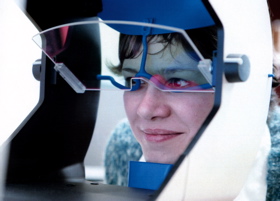
Eleonóra Víg
Senior Applied Scientist
Amazon
vig_nora@yahoo.com
I am a senior computer vision scientist at Amazon, in Berlin, Germany. My research interests include saliency prediction, multi-object detection and tracking, and human action recognition, using deep learning techniques and the simulation of virtual worlds.
About me
I received my PhD in Computer Vision from the University of Lübeck, Germany, for work on human gaze prediction and guidance in videos. In the following two years, I was a postdoctoral research fellow in the Computer and Biological Vision Lab of David Cox at the Center for Brain Science, Harvard University. During my Post-Doc, I was partly funded by a German Academic Exchange Service (DAAD) grant. From 2013 to 2016, I worked as a research scientist in the Computer Vision group at Xerox Research Centre Europe (now Naver Labs Europe), in Grenoble, France. Between 2016 and 2019, I was with the Remote Sensing Technology Institute of the German Aerospace Center (DLR) working on aerial computer vision, including human crowd analysis and the modeling of traffic participants for autonomous driving. Since Sept. 2019, I am a senior applied scientist at Amazon.
News
- (07/2021) Our paper on learning attribute-driven disentangled representations for interactive fashion retrieval to appear at ICCV 2021.
- (05/2021) We received an Amazon Accessibility Award 2021 - in the Innovation category - for improving the accessibility of product images for the blind and visually impaired.
- (09/2019) I am excited to join Amazon as a Senior Applied Scientist.
- (07/2019) Our paper on fine-grained semantic understanding of aerial scenes to appear at ICCV 2019.
- (09/2018) Honored to be an invited speaker at the 2019 German-American Frontiers of Engineering Symposium (GAFOE) organized by the U.S. National Academy of Engineering and the Alexander von Humboldt Foundation.
- (09/2018) Paper on object detection in unconstrained aerial imagery to appear at ACCV 2018.
- (03/2018) Our team won the 2nd prize at the IEEE GRSS Data Fusion Contest.
- (09/2017) I was awarded a Helmholtz Young Investigators Group grant (1.8 Million Euros).
- (12/2016) Thanks to NVIDIA for supporting my research with an NVIDIA GPU Grant.
- (10/2016) Paper on action recognition to appear at ECCV 2016.
- (10/2016) I am co-organizing the first workshop on Virtual/Augmented Reality for Visual Artificial Intelligence (VARVAI) at ECCV 2016.
- (06/2016) Two papers accepted at CVPR 2016 on virtual worlds and on saliency prediction.
Selected publications
My Google Scholar profile.
Y. Hou, E. Vig, M. Donoser, L. Bazzani. Learning Attribute-driven Disentangled Representations for Interactive Fashion Retrieval. ICCV, 2021.[paper] [code]
S. M. Azimi, C. Henry, L. Sommer, A. Schumann, E. Vig. SkyScapes - Fine-Grained Semantic Understanding of Aerial Scenes. ICCV, 2019.[pdf]
S. M. Azimi, E. Vig, R. Bahmanyar, M. Körner, P. Reinartz. Towards Multi-class Object Detection in Unconstrained Remote Sensing Imagery. ACCV, 2018.[pdf]
C. de Souza, A. Gaidon, E. Vig, A. M. Lopez. Sympathy for the Details: Dense Trajectories and Hybrid Classification Architectures for Action Recognition. ECCV, 2016.[pdf]
S. Jetley, N. Murray, E. Vig. End-To-End Saliency Mapping via Probability Distribution Prediction. CVPR, 2016. (spotlight presentation)[pdf] [bibtex]
A. Gaidon, Q. Wang, Y. Cabon, E. Vig. Virtual Worlds as Proxy for Multi-Object Tracking Analysis. CVPR, 2016.[pdf] [bibtex] [dataset] [poster]
A. Gaidon, E. Vig. Online Domain Adaptation for Multi-Object Tracking. BMVC, 2015. (oral) [pdf] [bibtex]
E. Vig, M. Dorr, D. Cox. Large-Scale Optimization of Hierarchical Features for Saliency Prediction in Natural Images. CVPR, 2014. [pdf] [bibtex] [code] [poster]
M. Milford, W. Scheirer, E. Vig, A. Glover, O. Baumann, J. Mattingley, D. Cox. Condition-Invariant, Top-Down Visual Place Recognition. ICRA, 2014. [pdf] [bibtex]
M. Milford, E. Vig, W. Scheirer, D. Cox.
Vision‐based Simultaneous Localization and Mapping in Changing Outdoor Environments.
Journal of Field Robotics 31 (5), 780-802, 2014.
[pdf] [bibtex]
E. Vig, M. Dorr, D. Cox. Space-variant Descriptor Sampling for Action Recognition based on Saliency and Eye Movements. ECCV, 2012.[pdf] [bibtex] [dataset] [poster]
E. Vig, M. Dorr, T. Martinetz, E. Barth. Intrinsic Dimensionality Predicts the Saliency of Natural Dynamic Scenes. IEEE Transactions on Pattern Analysis and Machine Intelligence (T-PAMI) 34 (6), 1080-1091, 2012. [pdf] [bibtex]
E. Vig, M. Dorr, E. Barth. Efficient Visual Coding and the Predictability of Eye Movements on Natural Movies. Spatial Vision 22 (5), 397-408, 2009. [pdf] [bibtex]
Software and datasets
- Virtual KITTI
- A photo-realistic synthetic video dataset designed to learn and evaluate computer vision models for several video understanding tasks, such as object detection and multi-object tracking, scene-level and instance-level semantic segmentation, optical flow, and depth estimation. Link to the accompanying CVPR'2016 paper.
- eDN saliency
- Reference code for computing Ensembles of Deep Networks (eDN) saliency maps based on the CVPR'2014 paper "Large-Scale Optimization of Hierarchical Features for Saliency Prediction in Natural Images".
- Eye movement dataset for the Hollywood2 benchmark
- A large dataset of eye movements we collected from five subjects who performed the action recognition task for the Hollywood2 Action Recognition challenge. The accompanying ECCV'2012 paper can be found here.
Theme adapted from orderedlist/minimal.